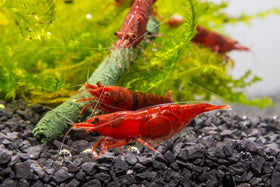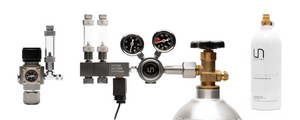
A Beginner's Guide to Tissue Culture Plants
Tissue culture plants, now easily accessible through aquascaping supply stores and online retailers, come conveniently packaged in sealed cups. They've gained popularity among hobbyists because of their sterile and self-contained in-vitro cultivation process. This method of growing plants naturally eliminates the risk of introducing unwanted pests or algae to your planted tanks.

This article will highlight the benefits of using tissue culture plants in aquascaping. We'll also explore the differences between tissue culture and potted plants, and we'll finally end with how exactly to use tissue culture plants in your next planted setup.
Keep reading to discover why you should consider using tissue culture aquatic plants in your next planted tank!
This article will go over:
- What Are Tissue Culture Plants?
- Tissue Culture vs. Potted Plants
- Pros and Cons of Tissue Culture Plants
- How To Plant Tissue Culture Plants
- Final Notes on Tissue Culture Plants

What Are Tissue Culture Plants?
Tissue culture plants are live aquatic plants propagated asexually through a process called in-vitro culture. During this process, individual plant cells are harvested, placed in a nutrient-rich medium, then left to grow in sterile conditions. This asexual reproduction method gives rise to entirely new plants that replicate the characteristics of the original plant.
When you buy tissue culture plants, they come in sealed plastic cups with clear jelly at the bottom. This substance is a nutrient-rich growth medium that supports the plant's roots and overall survival in transit. The sealed cup traps humidity, ensuring the plants don't dry out.
Tissue Culture vs. Potted/Bunched Plants
Potted and bunched plants have been staples in the freshwater aquarium hobby for most of its history, serving as the most popular and obvious choice for aquarists when acquiring plants for a planted setup.Potted plants usually come in plastic net pots surrounded by rock wool. The pot anchors the plant, provides a stable base for its roots, and preserves moisture. Bunched plants are trimmed stem plants arranged in groups of three or more stems. The stems are often wrapped in foam to protect the roots, with plant weights securing the bottom to anchor the stems down in the substrate and prevent them from floating.
Aquatic plant farms generally produce both potted and bunched plants, typically cultivating them in an emersed state (grown above the water). These plants experience robust growth, a reduction in the risk of algae, and improved survival rates during shipping. Their stronger plant growth and faster acclimation mean, they are not as susceptible to melt after being placed in an aquarium as they're able to quickly grow submersed leaves to replace the emersed-grown ones.
While the durability of potted and bunched plants is advantageous for aquatic environments, there are a few drawbacks to consider. There is a potential risk of introducing pests, pesticides, pathogens, algae, or undesirable plants like duckweed into the aquarium through emersed-grown plants. Fortunately, this concern can be addressed by diligently cleaning your plants with a bleach dip and/or quarantining.

Pros and Cons of Tissue Culture Plants
Tissue culture plants offer unique advantages over their potted and bunched counterparts:
Pro #1: Worry-free plants
Because tissue culture plants are grown in sterile conditions unlike potted plants, they are entirely pest, pesticide, and algae-free. This ensures that nothing unwanted is introduced to your planted freshwater tank, like planaria or snails. Moreover, in-vitro plants guarantee no harmful pesticides or pathogens will enter your tank, making them a secure option for aquariums with sensitive fauna like shrimp.
Pro #2: More bang for your buck
While they typically come with a higher price tag, tissue culture plants generally yield more plantlets per cup compared to their potted or bunched counterparts—so you can maximize the value of each tissue culture!
Pro #3: Easy plant preparation
Preparing in-vitro live plants for your aquarium is easy. When you're ready to plant, simply open the cup and remove the plants. Gently rinse them in a container of water to remove the jelly or liquid substance supporting the roots. Afterward, divide the plants into smaller portions for planting into the substrate, and you're all set!
For a visual guide on preparing tissue culture plants, watch the video below:
Unfortunately, the sterile nature of in-vitro plants comes with a few drawbacks:
Con #1: Patience required
These plants may take longer to adapt to a new aquarium because they have to transition from a sterile environment to one teeming with bacteria and other microorganisms. In-vitro cultivation produces more sensitive plants, increasing the chance of plant melt during the first stages of introduction into the aquarium.
This is why it's important to keep up with regular maintenance and water changes after planting. You can also minimize the risk of melt by planting in a properly cycled aquarium. Lastly, give your tissue culture plants the best environment possible by ensuring proper lighting and nutrients are supplied.
Con #2: Smaller plants
Tissue culture plants tend to be smaller due to their compact growth conditions. Although they will eventually grow to match their adult counterparts, it may take more time to develop the lushly planted aquarium you may be trying to achieve.
Con #3: Can't wait to plant
Tissue cultures have a limited lifespan in their cups, and their condition can deteriorate if left in the cup too long. To ensure optimal health, purchase fresh specimens and plant them right after receiving them.
- Hot Tip: Store tissue culture plants in a bright, cool room to prolong their vitality while still in the cup. Avoid keeping them in your fridge - this is too cold and dark of an environment for any freshwater aquatic plant.

How To Plant Tissue Culture Plants
While tissue culture plants might seem intimidating at first, they are straightforward to work with:- To start, fill a shallow bowl with some dechlorinated water.
- Open the tissue culture cup. Using two fingers, gently grasp a small portion in the middle. Pull lightly to separate the plant bunch from the cup.
- Gently rinse off the bottom jelly of the tissue culture plant in the water dish. Be sure to remove as much gel as possible from the roots.
- Divide the bunch into smaller portions for easy planting.
- Lay the plants out on a tray or flat open surface while misting frequently to prevent them from drying out.
- Use aquascaping tweezers or pinsettes to strategically plant small portions into the substrate.
Inserting the tissue culture plant into the soil requires a technique that you'll quickly master with some practice. Using the pinsettes, pinch the lower root portion of the plant clump and bury the plant halfway into the soil. Once the plant is set, turn the pinsettes down a few degrees, release tension slowly, then gently pull the pinsettes out of the soil.
While it's possible to insert the plant portions straight in and pull out the same way, this technique may result in more plants being unearthed. When pulling the pinsettes out at an angle, you may see some soil being pushed out from the side; simply use your tool to push the soil back into place.
Keep in mind that epiphytic tissue culture plants, like Bucephalandra, should not be planted in soil. This can suffocate the rhizome and cause the plant to melt and die. Instead, you can attach them to hardscape with aquarium-safe super glue or thread, or simply place them in cracks of hardscape.

Final Notes on Tissue Culture Plants
Thanks to the growing popularity of in-vitro cultivation, aquascaping enthusiasts can now easily access clean plants through online retailers and aquascaping supply stores.
Commonly available in sealed cups, the sterile and self-contained nature of tissue culture plants symbolizes an evolution in the hobby. Tissue culture specimens not only guarantee convenience, they also eliminate the potential risks associated with introducing unwanted pests or algae to established planted tanks. After discovering the numerous advantages of tissue culture specimens, you now have the insights to incorporate this innovative form of freshwater plants into your upcoming planted setup.
Shop our selection of tissue culture plants HERE!
Tell us - Was this article helpful? Please leave a comment below!
If you have any questions regarding this article, please email support@buceplant.com, or DM us on Instagram or Facebook so we can assist you directly - @buceplant





Comments
Leave a comment